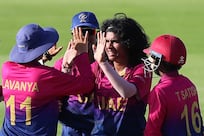Many of those that watched Bhuvneshwar Kumar's stunning Twenty20 debut on Christmas evening in Bangalore were transported back more than two decades, to a disappointing tour of Australia that saw India overwhelmed 4-0 in a five-Test series.
Kapil Dev would go on to play two more seasons, but that series, in which he took 25 wickets, was to be the last time India fans would see him at his best as a swing bowler.
The delivery that Bhuvneshwar bowled to dismiss Nasir Jamshed was vintage Kapil, the inswinger to the left-hander that ruthlessly exploited hesitant footwork. Kapil used it to get both Mark Taylor and Allan Border during that Australia series, and there were echoes of his dismissal of Qasim Umar in the World Championship of Cricket final (1985) in the way Bhuvneshwar flummoxed Umar Akmal with dramatic movement into the batsman.
Bhuvneshwar is just 22 and has built up a solid domestic record over five seasons with Uttar Pradesh. Until the Pakistan game, his primary claim to fame was dismissing Sachin Tendulkar for nought. But with 149 first-class wickets, including 27 from six games this season, it was obvious that there was more to him than one career highlight.
There has been a reluctance to pick men such as Bhuvneshwar and Pankaj Singh, bowling talisman of the Rajasthan team that won back-to-back Ranji Trophy titles, because they don't exactly push the speedometer to the limit. Both are medium-pace bowlers who can swing the ball and get it to cut off the pitch. What they lack in pace, they make up for with accuracy and the ability to bowl lots of overs.
India lacked a genuine pace option for so long after Javagal Srinath's retirement in 2002 that the focus since has invariably been on those that could hurl the red cherry at maximum velocity. VRV Singh played when Greg Chappell was coach, but for every delivery that disconcerted the batsmen, there would be half a dozen others that upset his captain more.
Munaf Patel seemed like the real deal when he took seven for 97 on debut against England in Mohali, bowling India to victory with a superb spell of reverse swing. But the boy from Ikhar in interior Gujarat seemed ill at ease in the world of professional sport, and earned a public rebuke after the South Africa tour of 2006-07 for allegedly hiding an injury. He has seldom been the same since, and the highlights have been as sporadic as his appearances.
Varun Aaron, who bowled at 150 kph in his debut Test in Mumbai last year, broke down almost immediately and has not been seen since the last Indian Premier League, while Umesh Yadav, consistently quick and hostile, went on to the injury list after playing a telling role in India's win over England in Ahmedabad.
The others to impress this season are all medium-pacers. Sandeep Sharma was an integral part of India's Under 19 World Cup win earlier in the year, and he has continued his progress with some strong displays for Punjab. Aside from his accuracy, his ability to bowl yorkers in crunch situations marks him out as someone special. Ishwar Pandey, of Madhya Pradesh, is another who bowls medium pace, and the only one ahead of Sharma in the Ranji Trophy wicket-taking charts.
Bengal's Shami Ahmed has already been picked for the ODI games against Pakistan, and there have been encouraging performances from Orissa's Basant Mohanty and Kerala's Sandeep Warrier.
No matter which country you are playing in, swing - both with new ball and old - troubles the best batsmen. With the search for a pace ace not having thrown up too many likely suspects, perhaps it is best if India look for someone who can do what Kapil did with such distinction for more than a decade.




